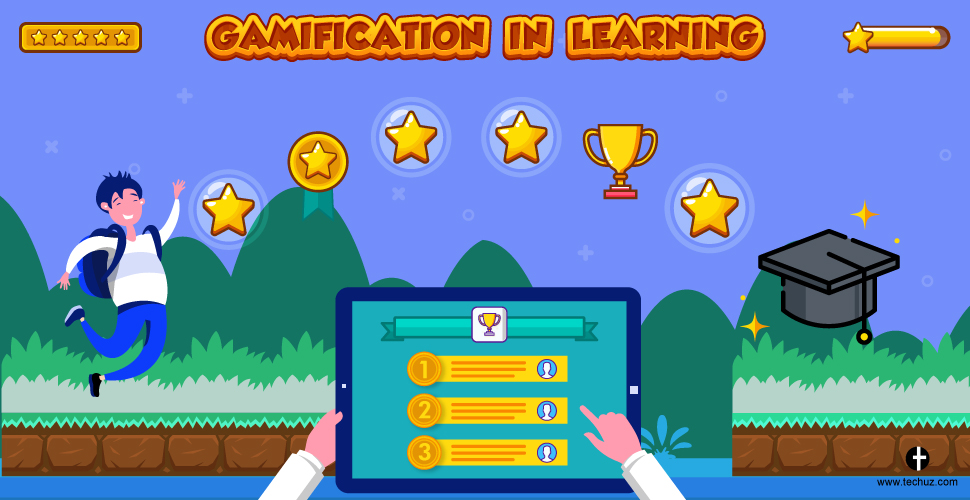Posted on
June 28, 2019
Updated on
March 26, 2024
Read time
 14 mins read
14 mins read
Imagine you are immersed in another world — moving forward with excitement. The bursts of pleasure you get while collecting rewards are priceless, you conquer the obstacles on the way, the anticipation remains at apogee to unlock new levels, discover new terrain and finally — the ecstasy of becoming the winner.
Sounds familiar?
Well, that’s how we feel while playing a game.
At some point in life, we all have played games — virtual or real. And the experience is delightful — motivating us to play more, score points, complete the challenges and achieve feats. Reports show that there are 3.2 billion gamers worldwide making video games an enormous giant in the world economy. Some reports have also forecasted that it is expected to grow to $300 Billion in 2025. And looking at these trends — there seems no sign of slowing down.
But it’s not just the game industry that’s proliferating, a theory stemmed from gaming is showing a promising trajectory. And this theory is known by the name “gamification”.
In this article we’ll discuss:
- What is gamification?
- How does it work?
- Gamification in education.
- Game elements and how to apply them in education.
- Popular gamified platform that made it huge.
What is Gamification?
Gamification is the process of incorporating game elements into non-gaming activities to trigger certain user behaviors. The game elements may include a range of gaming mechanics and dynamics such as badges, levels, leaderboards, points and XPs that motivates the user to take actions to achieve them.
At its heart, the prime goal of gamification is to drive more engagement and inspire the user to participate more often in a process, activity or content.
Though the concept of gamification is here for a while now, in recent times, its use has been proliferated across all domains and industries. According to a report, the gamification market in 2016 was estimated at $4.91 billion which is expected to grow to nearly 12 billion in 2021. In fact, many web and mobile applications we use on a daily basis underpin gamification principles to engage the audience and make their applications and portals more interactive.
Gamification market is expected to grow to nearly 12 billion in 2021.
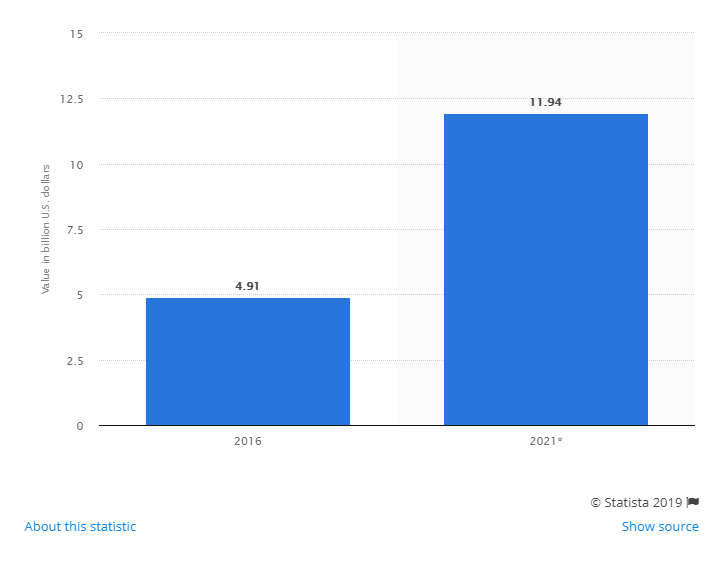
(Source – Statista)
Here, check these examples of gamification. Probably you might have come across them.
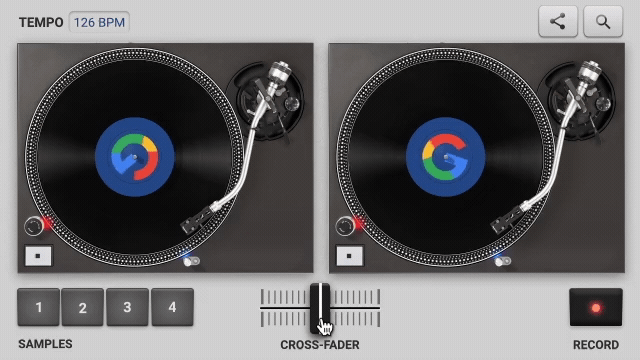
(Google Doodle – Here’s an amazing example of gamification by Google. On the 44th anniversary of Hip Hop, Google introduced an interactive gamified doodle that lets the user drop the beats! As the user completes different tasks on the turntable, they unlock achievements. This doodle was a massive success with a large number of impressions and engagement all over the world.)
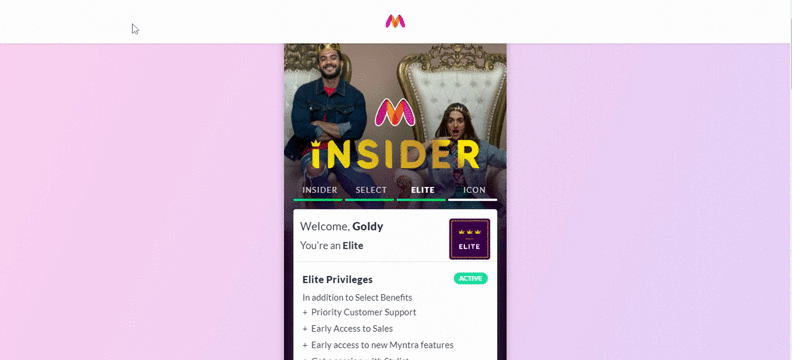
(Myntra Insider Program – Online fashion e-commerce company Myntra came up with a gamified loyalty program named “Myntra Insider”. The program aimed to acquire new users and improve engagement, rewards the members for purchases and provides different badges and levels for exclusive perks and privileges. )
Alright, you know what gamification is — and you also know that it can turn dull things more compelling, so now let’s understand how gamification work.
The Why and How of Gamification
The why and how of gamification can be summarized in three words: Brain, motivation and dopamine.
How? I’ll explain.
Whenever we are excited or experience pleasure, a neurotransmitter called dopamine is activated in our brain. To put it simply — dopamine is a chemical that makes you feel good. And all the games are designed to release this chemical in our brain.
You defeat an opponent, dopamine is activated. Unlock a new level, dopamine is released. You see your name on the leaderboard — again, dopamine.
So whatever process or activity that is gamified by applying the game elements have the same effects as a game does. You earn points, receive rewards, overcome challenges, unlock new levels or see your name on the leaderboard — your brain releases dopamine that makes you feel good and motivates you to chase after more rewards.
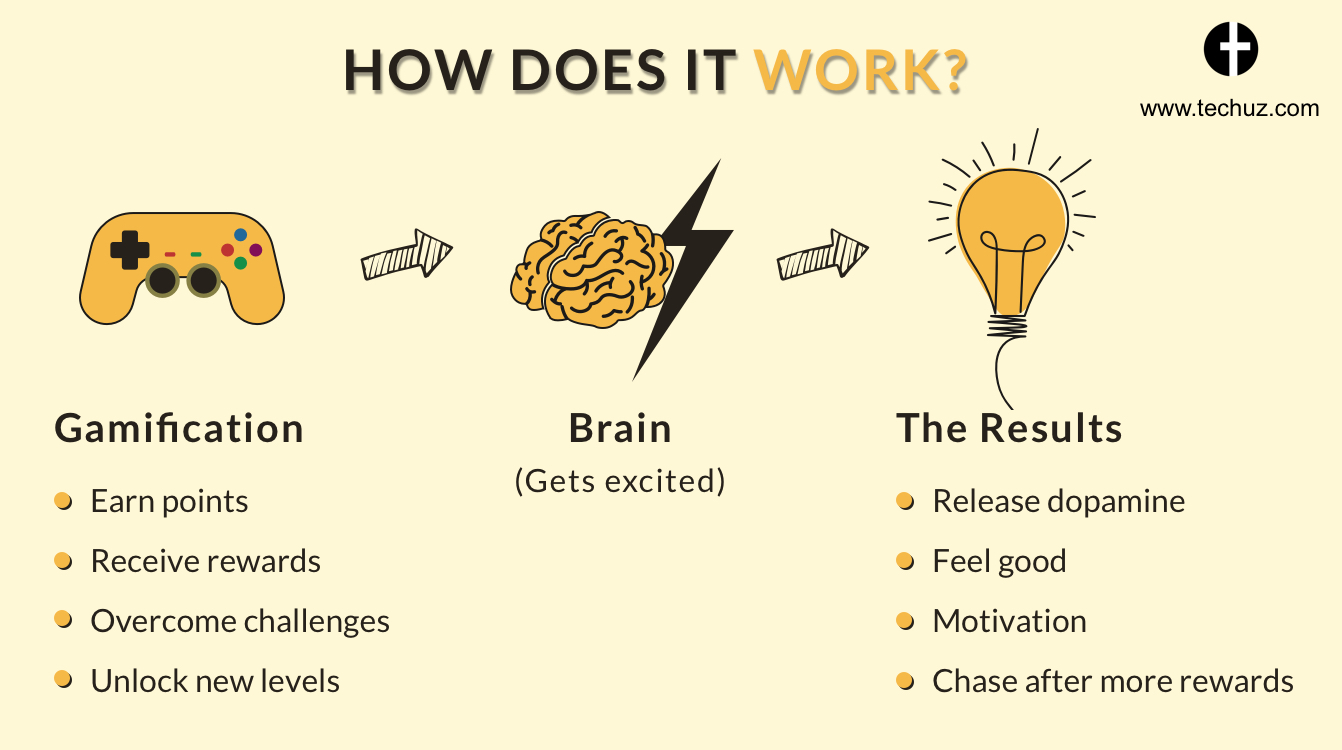
(Gamification and our brain – How gamification works)
Gamification in Education
Without a doubt, gamification is a smart strategy to influence and motivate people whether they are customers, employees, patients or (of course) students. In fact, triggering the basic human desires with gamification to engage the learner, motivated and enhance the overall learning experience has rejuvenated the learning process.
Consider this scenario: Kids hate reading or doing their homework. Staying awake late at night to study might not sound something exciting to them.
But when it comes to playing games — they are ready to sacrifice their sleep just to boost the XPs and unlocking new levels. They experience a sense of accomplishment when they progress in the game. So when gaming elements are combined with education, it facilitates both fun and learning at the same time.
This eventually results in learner spending more time on learning willfully as they engage themselves in collecting rewards and completing the game challenges. Let’s understand the gamification elements and how they are applied to education and learning.
Elements of Gamification & How to Use them in Education
The rewards, badges, leaderboards or any similar elements that motivate the user or satisfy the desire are game elements. These elements can be divided into two categories — game mechanics and game dynamics.
Game Mechanics
Game mechanics are used to gamifying any process or content. They drive and encourage user behavior through rewards, points, feedbacks and other kinds of incentives. The game mechanics are the foundation for gamification of a non-gamified entity.
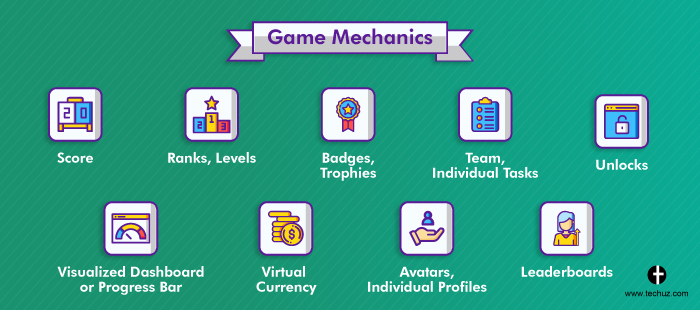
List of Game Mechanics:
- Score
- Ranks, Levels
- Badges, Trophies
- Team, Individual Tasks
- Unlocks
- Visualized dashboard or progress bar
- Virtual Currency
- Avatars, Individual Profile
- Leaderboards
Game Dynamics
Game mechanics can drive the user motivation for a while; however, when things get repetitive — the user gets bored with the game. That’s when game dynamics comes in. These game dynamics combines the user’s behavior with the game mechanics and evolves them over time to avoid making the game monotonous.
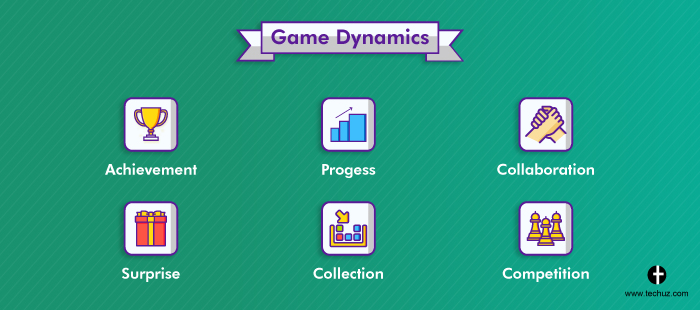
List of Game Dynamics
- Achievements
- Progress
- Collaboration
- Surprise
- Collection
- Competition
How to Use These Game Elements in Learning
Score, Points and XPs
Collecting scores, points or XPs make the learner feel rewarded and these are among the prime motivator. The scores and points collected unlocks new levels for the user and can also be used to unlock more content on the platform.
How to use it?
The grading system can be based on these rewards where the learner is rewarded for every effort made. There’s no punishment for underperformance but just rewards for the efforts. This way of cumulative rather than reductive grading proves to be efficient as each evaluation and tests feel rewarding and not discouraging.
Even the students are motivated to demonstrate their competence by progressing and scoring more just like one does in games.
For instance, based on the lesson, students are given a quiz to evaluate their understanding. When they give the right answers, a small reward such as XP is provided for the efforts.
A great example of this reward based grading is incorporated by professor Lee Sheldon of Indiana University. Instead of assigning grades to his students, he gives “experience points” at the end of the course. Each student starts with zero and earns experience points for tests and projects. Sheldon says that this system of grading motivated by game theory makes the learning fun activity rather than boring education.
Levels and Challenges
Levels are the common mechanics in the games. You complete the challenges, progress to a certain threshold and a new level is automatically unlocked. A high number of unlocked levels in the game also determines the expertise as it requires the user to spend more time, complete challenges, tasks and milestones.
How to use it?
Levels can be a great way to define the learner’s journey. Starting from the basics of the subject with simple tasks and gradually increasing the level of difficulty as the student progress in the module. This gradual increase in difficulty and complexity while progressing to new levels gives the user a sense of development and they improve their competence.
DuoLingo is one such language learning platform that uses levels. As the learner progresses and masters each level of the language, his XP increases and he unlocks new levels. The app provides 25 levels for each language and the user can achieve it by accumulating the necessary language skills.
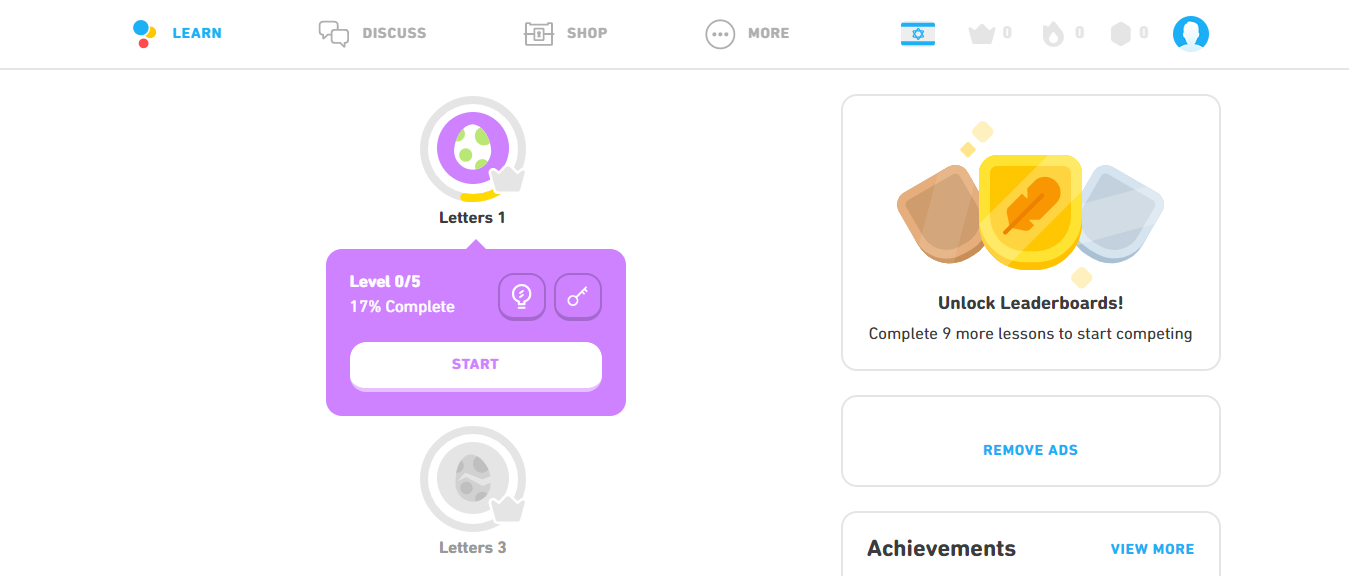
(DuoLingo – Language learning platform)
Yousicisian, an interactive music learning application to learn guitar, piano, bass, ukulele and even singing provides the user with missions and levels. The user starts with level 0, i.e. a complete beginner and progresses based on his mastery on chords and melodies. By the time the user reaches level 15, he is able to play the instrument virtuously.

(Yousician – A platform to learn music instrument)
Badges and Trophies
Badges and trophies in gamification work the same way as in the real world. Just like the soldiers are awarded badges for their bravery or different colors and tags of credit cards represent the credit limits, these badges and trophies are a symbol of status in gamification. And users can exhibit these badges on their profile to show off their feats.
How to use it?
Badges and trophies can be awarded to the students for their achievements and feats. On completion of different challenges, assignments or tasks, the student can be awarded a badge and trophy that is visible on their profile. One of our clients, Getlitt, has incorporated the same badge system.
Getlitt is an online book reading platform with a motto to develop reading habit among children. Kids earn badges as they complete reading the books and perform related tasks such as quizzes or vocabulary and grammar mastery. Kids even earn trophies as they finish the number of books in the challenge.
Another great instance of this is Khan Academy where students can earn badges on completing the courses. They have an entire page where students can watch the videos and answer the questions or solve the problems and win badges for the course. Even Codeacademy an online platform to learn coding languages provides a badge on completion of each course. However, one thing that you must keep in mind while incorporating badges is that the badges awarded should be something meaningful on the platform or community.
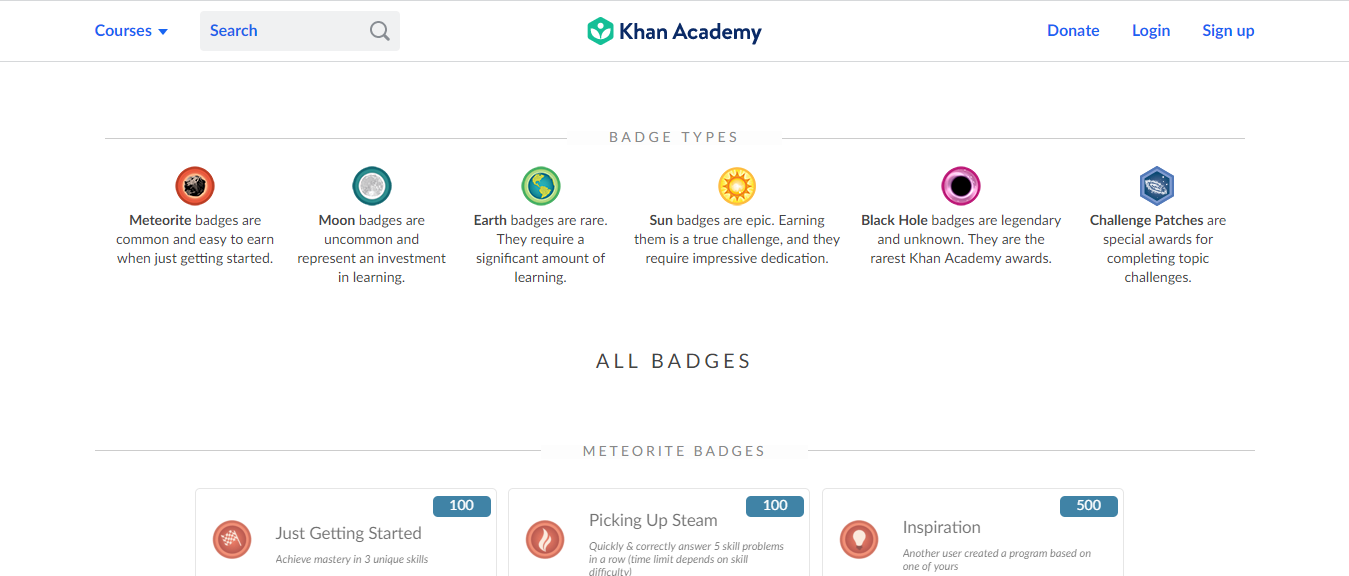
(Khan Academy- Free online courses and lessons)
Leaderboards and Competition
Competition is one of the motivations that push us to move forward and perform better. Leaderboards are one such game mechanism that inspires the users to perform to see their name at the top of the list. Most of the addictive games whether it be the all-time classic Pacman or Candy Crush Saga — all have leaderboards.
How to use it?
Learners with the best performance whether it be earning XPs, badges or trophies can be incentivized by featuring their name on the leaderboard. The learner puts extra efforts in the learning activity just to see the name on the top position or maintaining it.
Getlitt has also incorporated the leaderboards of the students based on the knowledge points (XPs) earned. The leaderboards are categories at micro levels such as friends and class and macro levels such as school, city, state and national level. Play.Typeracer, a gamified platform for increasing the typing speed also uses leaderboards to motivate the users. The platform provides the list of the latest high score, individual’s best score and a list of players with an all-time high score.
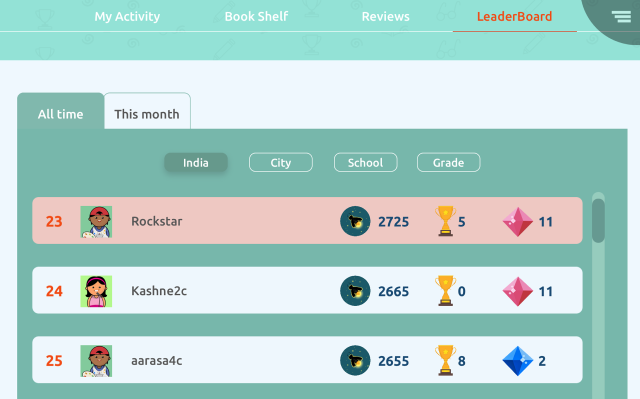
(GetLitt- Online book reading app for kids)
Some of the Popular Gamified Education Platform
Byju’s
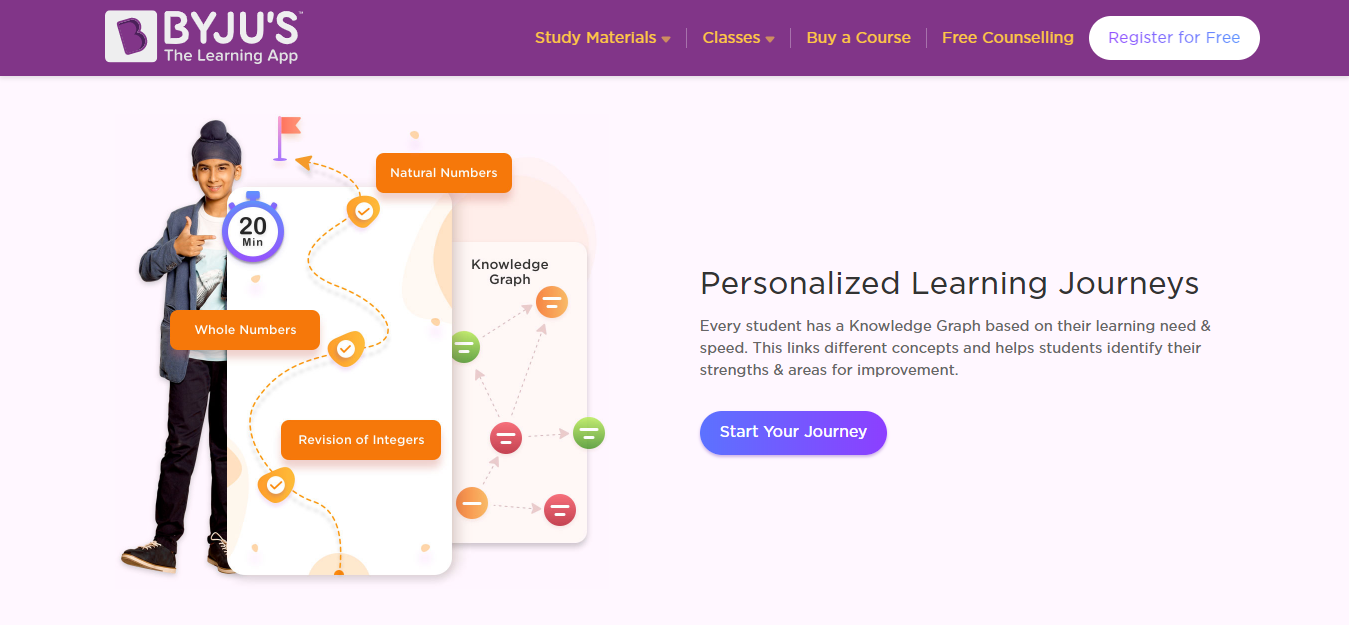
Byju is one of the leading Edtech startups offering a vast range of online materials for K12 and competitive exams such as CAT, IAS, GRE, JEE, NEET and GMAT. The company has a huge user base of 33 million users including 2.2 million annual paid users and 10+ million downloads on Play Store. As of 2019, Byju’s has secured funding of $785 million making it the most valuable EdTech startup in the world with a valuation of $5 billion.
The platform has incorporated game design and gamification elements with rich interactive videos to create learning more engaging and fun.
Khan Academy
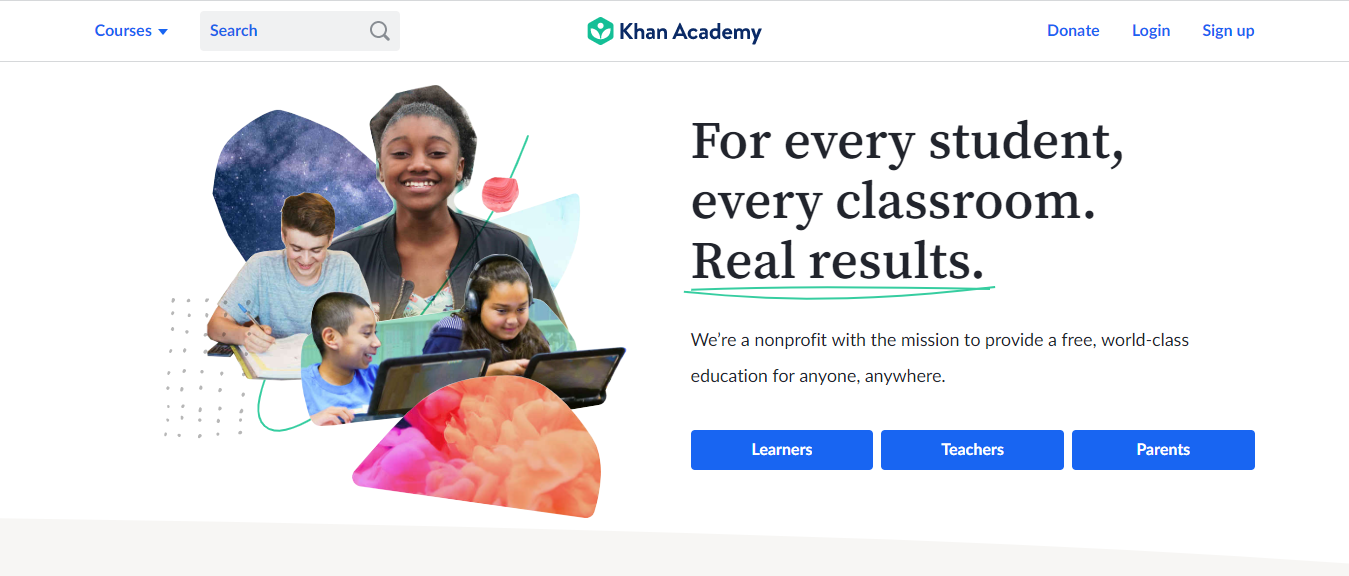
Khan Academy is another educational platform providing personalized learning to the students. They are a non-profit organization providing a range of courses for varied subjects starting from math, science, grammar, economics to music and world history, and is available in more than 36 languages. This gamified learning platform uses reward-based grading system where students are given XPs for completing the course modules. It also provides immediate feedback that helps the students to improve. Khan Academy has received a notable amount of donations from top-tier companies, organizations and philanthropists including Google, Comcast, Oracle, Bank of America, Bill and Melinda Gates Foundation and more.
DuoLingo
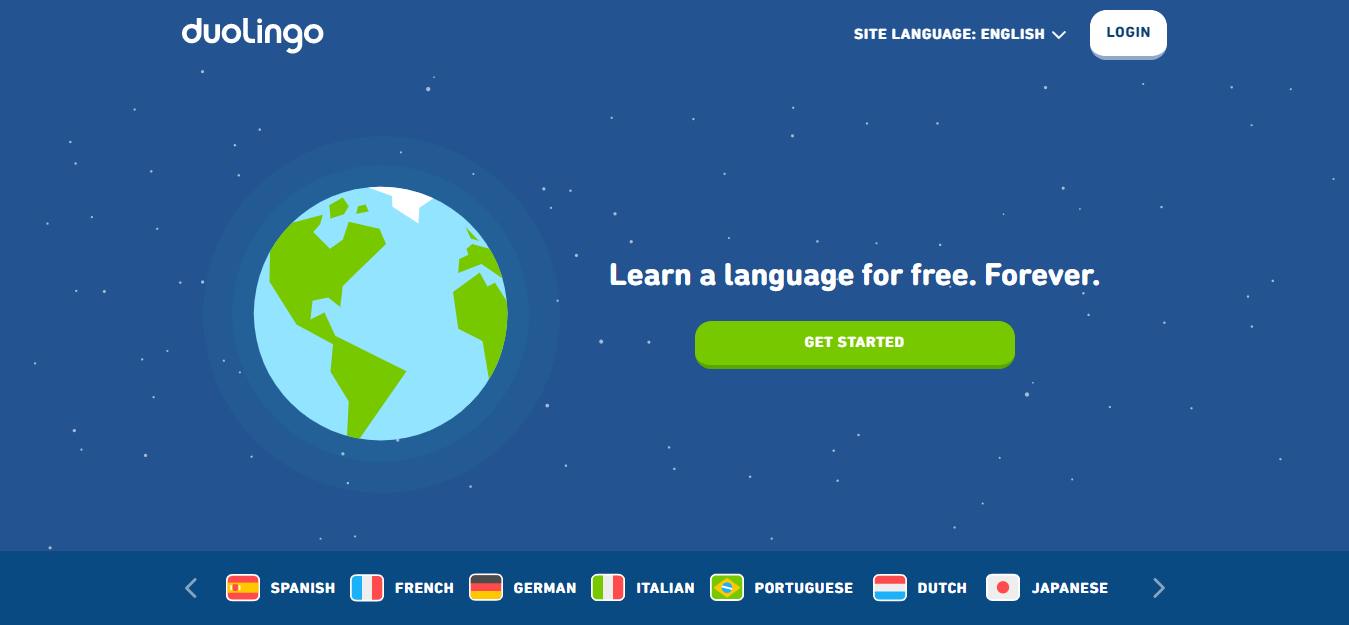
Duolingo is simple and effective language learning platform where with a massive database of languages courses including — Spanish, French, German, Italian, Russian, Portuguese, Duch, Irish Swedish, Ukrainian, Esperanto, Polish, Greek, Hungarian, Norwegian, Hebrew, Welsh, Turkish and English.
With a user base of 300 million learners, Duolingo is the world’s largest language learning platform. The entire platform is gamified where the learner progresses through different levels on completing quizzes and challenges while getting instant feedbacks for improvements. Each lesson of the courses in Duolingo consists of a range of activities to make language learning a delightful experience. The pedagogy of this gamified platform is so effective that multiple studies show 34 hours spent on learning on Duolingo is equivalent to a full semester of language education in a University.
Yousician
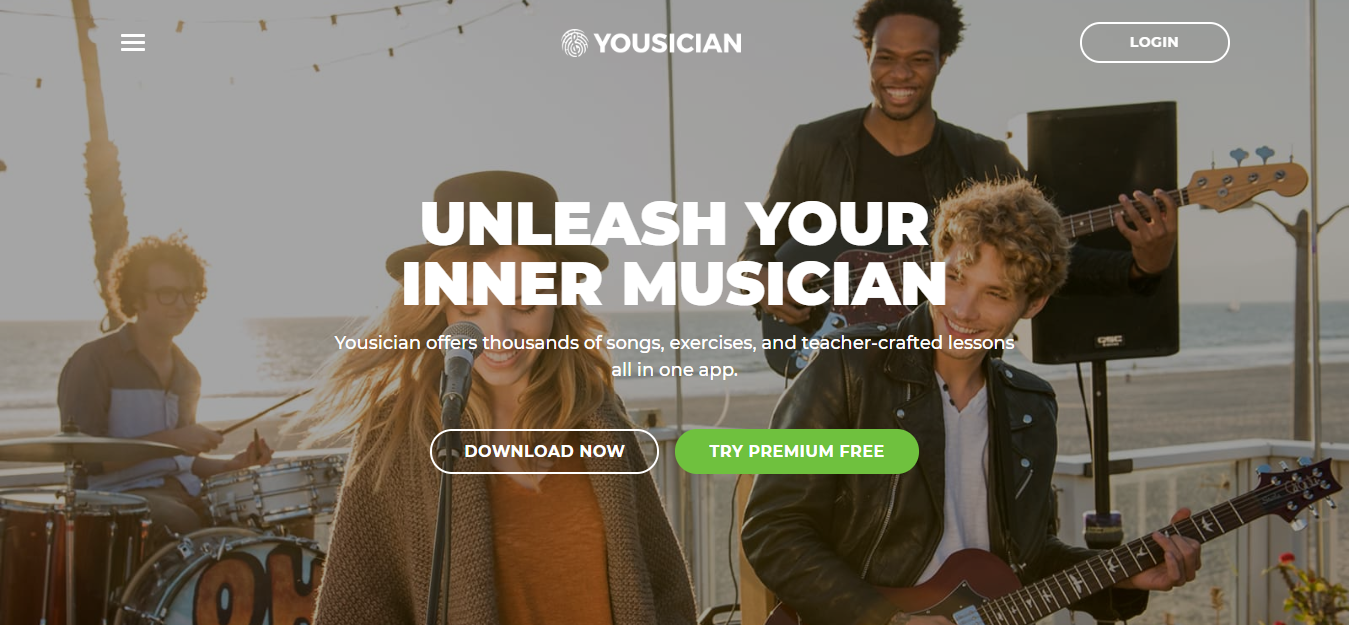
Yousician is a music learning app that has revolutionized music education. The user can choose to learn — guitar, ukulele, piano, bass and even learn singing. Here’s how it works:
This gamified music learning app is divided into different modes — mission, songs, daily goals and challenges. The learner gets daily exercise where he can practice the instrument and receive feedback in real time. As the user improves his proficiency and skills, he is able to unlock new levels and content in the learning journey. It also provides weekly challenges where the learner can compete with their friends and other app users worldwide.
Currently, Yousician has 10 million+ download on Play Store with over 257k positive reviews and is widely used by beginners and advanced musicians, music teacher as well as professional musicians.
Knudge.me
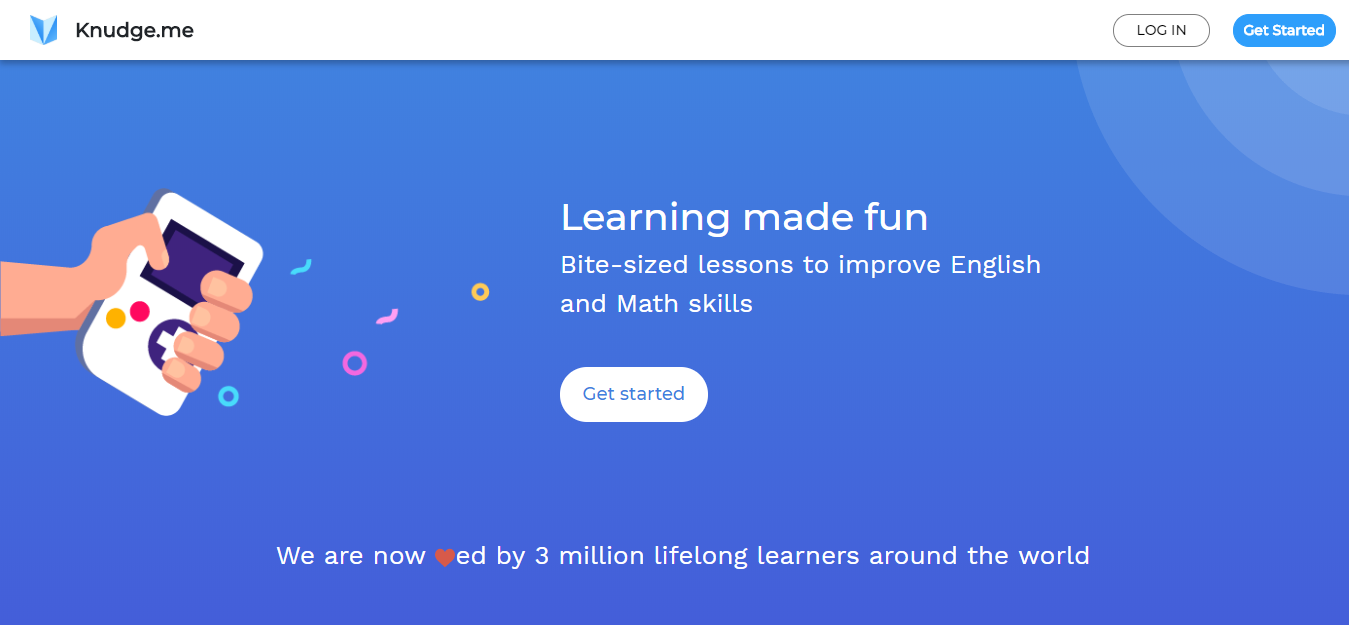
Knudge.me is another learning platform made for those looking to improve their English and Math. The app comes with small snackable lessons or as they describe “Bite-sized lessons” on English vocabulary, grammar, idioms, phrasal verbs, math tips and tricks and more.
The platform comes with almost a dozen of games such as — Space Pursuit (a game to improve writing skills), Jelly Fizz (to improve speaking skills), Word Race (to improve reading speed), Panda’s Trail (to improve grammar) and more fun games.
Knudge.me has been editor’s choice app on play store with 3+ million downloads and more than 43k positive (4.8/5) rating.
Wrapping Up
Now you know what is gamification, how it works and how this theory is bringing a paradigm shift in the age-old learning methods. Leveraging the game mechanics and dynamics into dull learning process motivates the learner intrinsically as well as extrinsically — resulting in better learning outcomes and experience.
Hope this article has given you good insights on gamification. And if you are looking forward to implementing it, we can help you out.
Techuz has deep expertise in developing EdTech and e-learning solutions and has delivered successful gamified learning platform.
Our team of designers and developers are proficient in web application development and developing learning platforms that ensure your content and courses deliver the best results to the learners.
Looking forward to developing your own gamified learning portal? Feel free to contact us!
